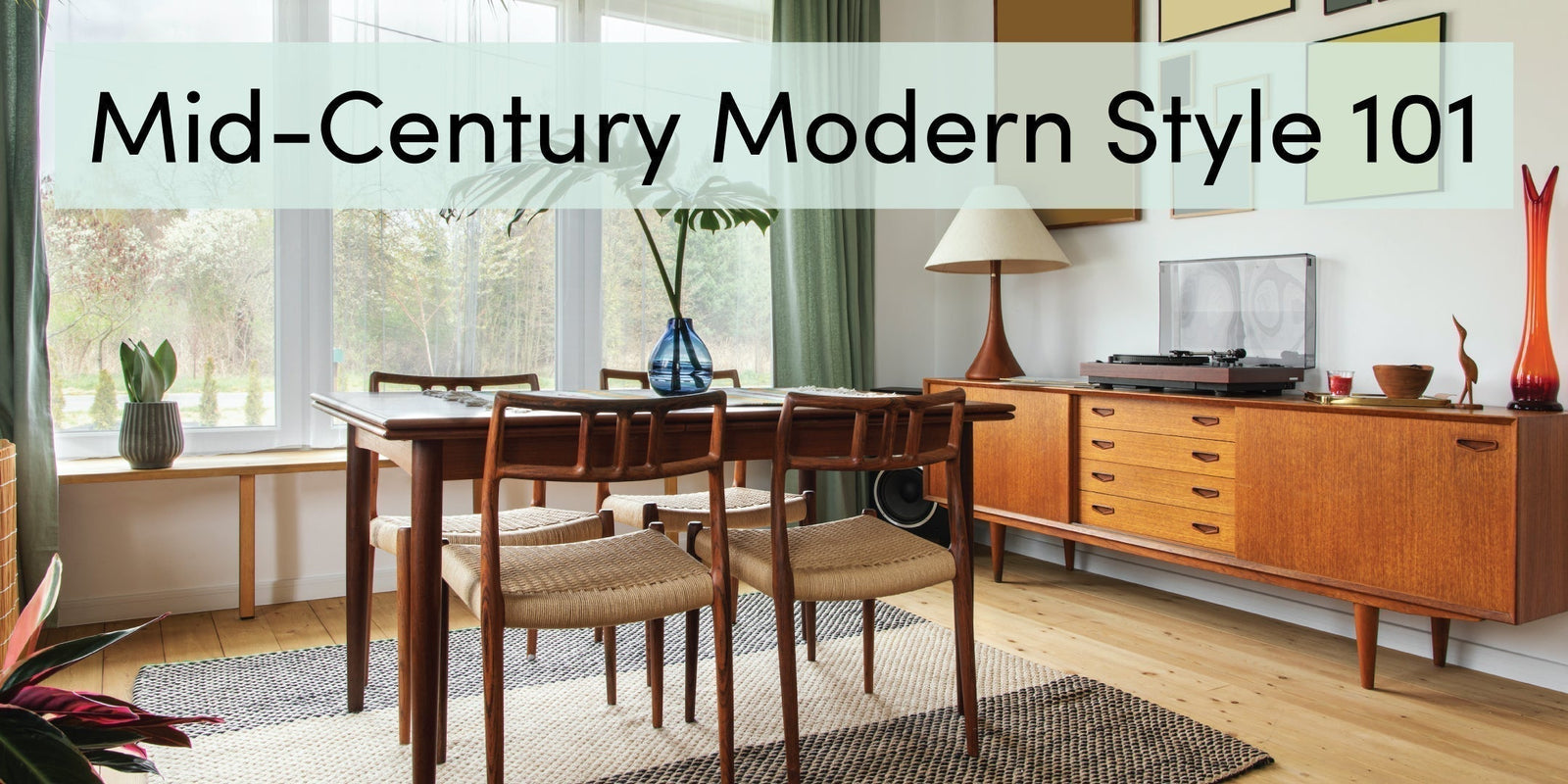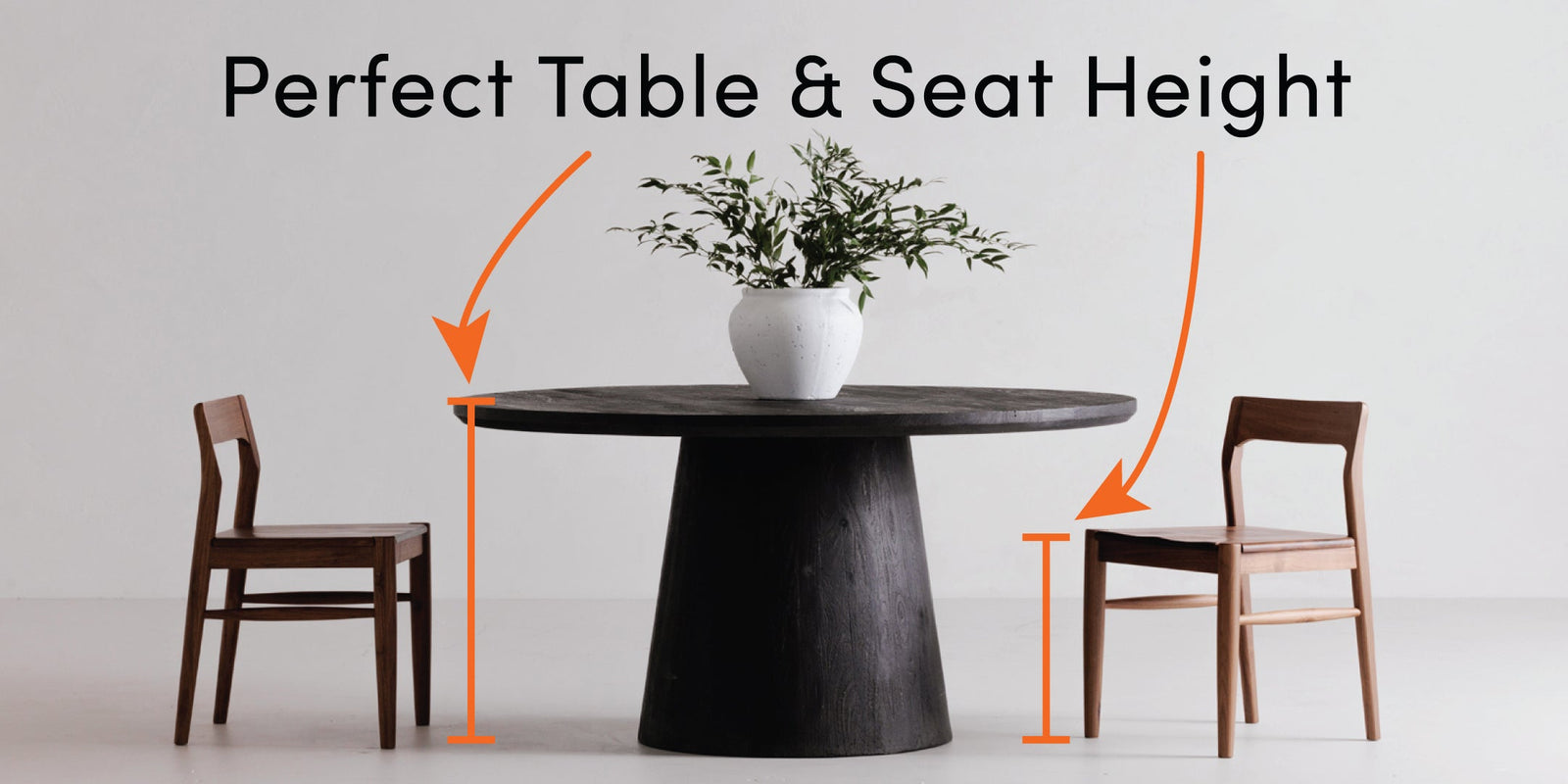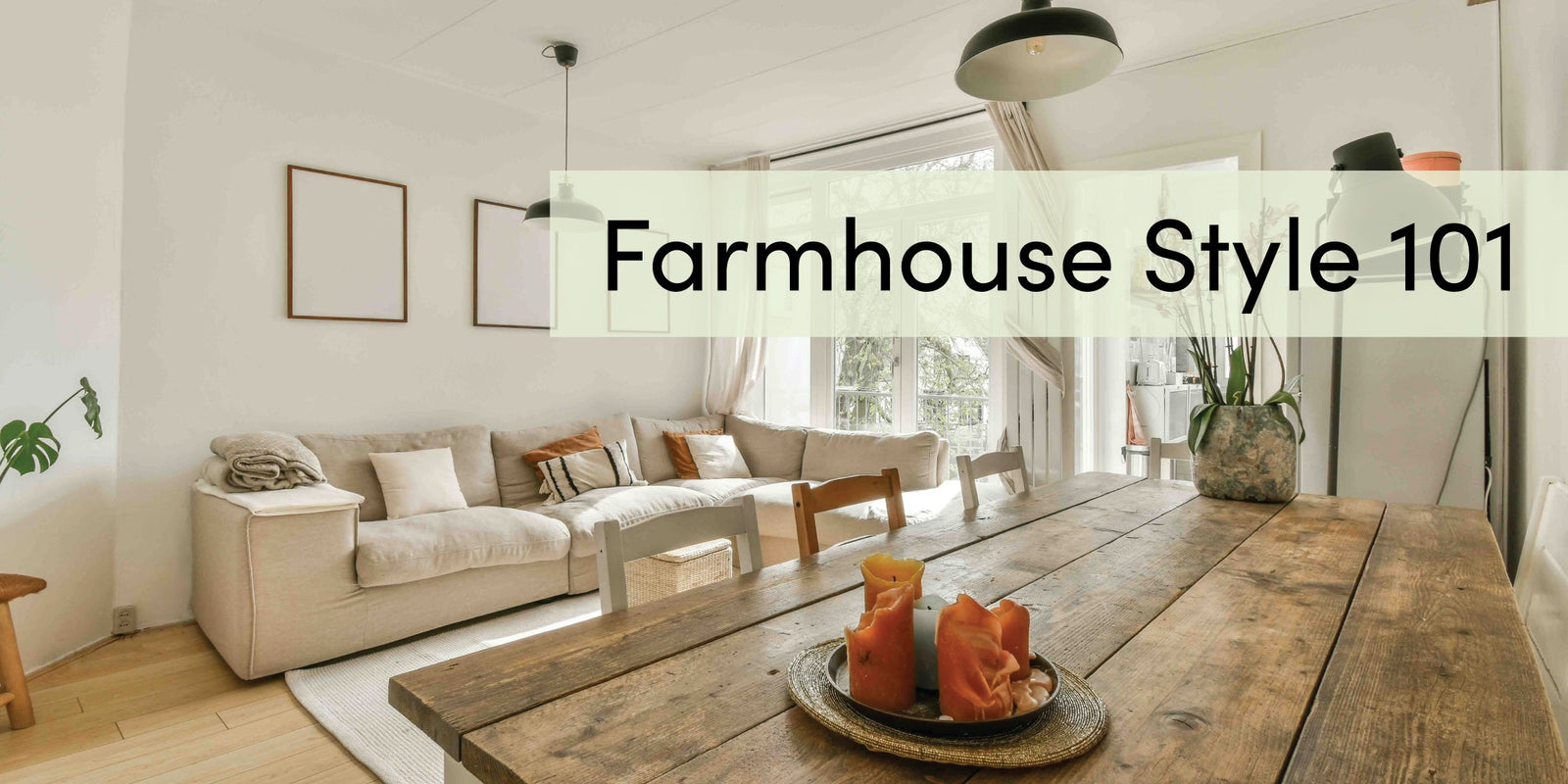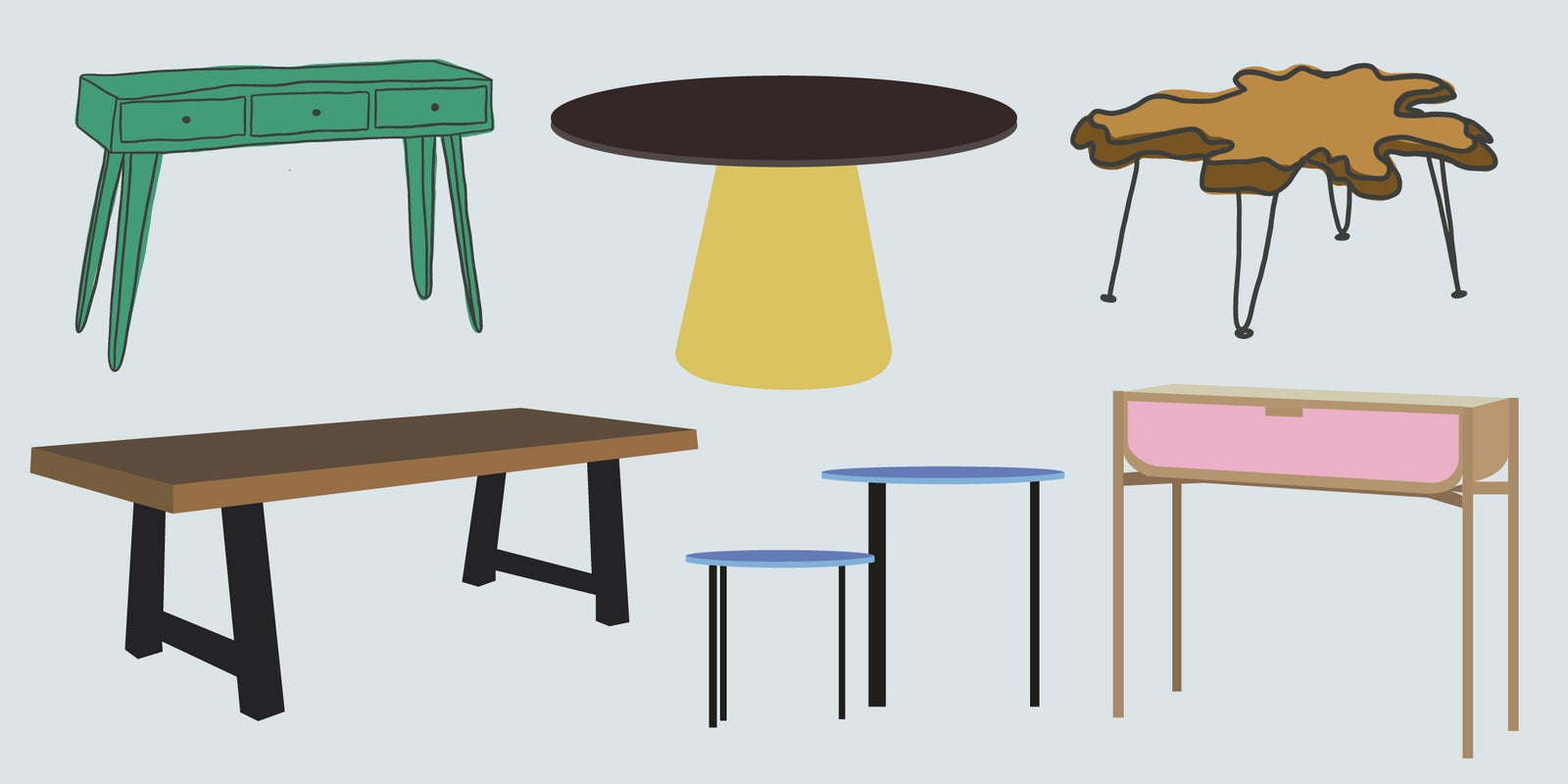Menu

0
Your Cart is Empty

Your Cart is Empty
by Maham Iftikhar Last Updated: May 09, 2025 May 05, 2025 12 min read
Mid-century modern interior design is more than just a temporary fad; it's a timeless aesthetic. Even though the origins of the mid-century modern style belong to the post-World War II era, this style had a massive comeback in the world of home decor and stayed for good.
From our many years of experience furnishing mid-century modern homes and commercial projects, we have created this comprehensive guide to help you design and decorate your space in mid-century modern style. Let's begin!

Mid-century modern is a design movement that emerged during the post-World War II period, roughly spanning the late-1940s to late-1960s. It had a profound impact across different design disciplines in the Americas and Europe, including interior design, architecture, and product design. Influenced by the Bauhaus movement and Scandinavian modernism, this style prioritizes functionality over form, peeling away excessive ornamentation in favor of clean lines and a minimalist approach.
Some of the most iconic industrial designers and architects of all time belong to the mid-century modern design era. Frank Lloyd Wright, the father of organic architecture and designer of Fallingwater; industrial designer Ero Saarinen for his iconic Tulip chair; and couple Charles and Ray Eames, the pioneers of molded plywood seating like the LCW and classic Eames Lounge Chair with Ottoman, are a few big names who shaped the mid-century modern style.
Interestingly, although the term "mid-century modern" was sporadically used as early as the 1950s, it wasn't formally canonized as a distinct design movement until the 1980s when people began to look back retrospectively.
Mid-century modern interior design feature several defining characteristics that give them their distinct, iconic look. They are as follows:

Mid-century modern furniture is known for their combination of organic curves and clean geometric lines. The iconic biomorphic coffee tables - kidney and amoeba-shaped tabletops supported by hairpin or sculptural wooden legs - exemplify this fusion perfectly.
They also focus a lot on functionality. As designer Ray Eames once said, "what works good is better than what looks good, because what works good lasts." In other words, well-designed furniture should be accessible and practical for everyday use - that means greater emphasis on ergonomics, efficient space usage, durability, and multi-functional capabilities.
When it comes to functionality, there are many furniture categories that you probably never heard of. For example, there are many different types of tables for each room serving different needs. First identify how you're going to use your space most often before shopping for furniture that best serves that use case.

In mid-century modern decor, colors are used to create harmony and contrast. Walls typically feature warm whites, soft grays, or natural wood panels that create gallery-like settings for furniture and art to shine. This neutral foundation is anything but boring - it's purposeful restraint.
Most of your furniture or rug choice should be in neutral base colors - the foundation of mid-century modern décor should not be too vibrant. Beige, gray, brown, cream, and white, artfully blended with earthy tones like rust, terracotta, and olive green, are popular options. Many of these warm neutral colors were drawn from natural materials like walnut, teak, and leather as they age and develop patina.
Where mid-century design gets colorfully expressive is through its distinctive accent palette. They're colorful, with a bit of desaturation to give it a more pastel hue. Popular accent colors include burnt orange, avocado green, mustard yellow, and teal/turquoise. These hues appear in the upholstery of sofas and bed frames, wall art, vases and decorative objects, and throw pillows.

The mid-century period (especially in the 50s and 60s) saw many new technological innovations and engineering techniques that revolutionized furniture production. Designers eagerly embraced these new possibilities, creating pieces that would have been impossible to manufacture in earlier eras.
Molded plywood techniques pioneered by Charles and Ray Eames allowed wood to curve and flex in unprecedented ways. Industrial engineers during the mid-century discovered how to consistently bend entire flat pieces of plywood by a careful process of steaming, bending, and bonding. This allowed designers to warp and shape wooden furniture in ways that were impossible before.
Fiberglass-reinforced plastic enabled mass production of single-shell chairs that were lightweight, durable, and shaped organically. A lot of these designs look straight out of the Jetsons cartoon. Acrylic and lucite introduced transparent frames as a design element, allowing furniture that seemed to disappear within spaces and opening up the visual lines within a room.

Lighting in mid-century modern is highly sculptural, reflecting the futuristic optimism of the times. As designer Bobby Berk said, "great lighting is often the unsung hero of mid-century interiors. Those sculptural fixtures aren't just functional - they're conversation pieces that transform spaces day and night."
The Sputnik chandelier, named after the Soviet satellite launched in 1957, epitomizes space-age design with its starburst form and multiple light sources extending from a central sphere. The multi-orb sources of light cast fascinating shadow patterns while illuminating every nook and cranny of a room.
The Arco Lamp by Achille Castiglioni started a trend in counterbalanced floor lamps. The tall, arching arm of arc lamps hold a single orb over a room from afar, offering benefits of a ceiling lamp without the complexities of mounted wiring.

Mid-century modern has a typical language of retro geometric patterns, which appear in both wall art, textiles, painted surfaces, and decorative objects.
Mid-century wall art is abstract, mostly geometric patterns in the aforementioned color palette of warm neutrals with contrasting accent tones. Wall art during this period embraced non-representational expression: think Alexander Calder's mobiles, Mondrian-inspired geometric compositions, and abstract color field paintings. Their goal is to evoke feelings rather than literal depictions of subjects or sceneries.
Decorative objects and vases became far less ornate, focusing more on sculptural shapes and simple pattern blocks. These pieces were typically arranged asymmetrically in small groupings rather than symmetrical displays. The goal was to create a space that was mentally relaxing while providing just enough visual intrigue.

One of the oft-forgotten attribute of the mid-century interiors is the intentional blend of smooth and textured surfaces, which creates depth and dimension even within minimalist designs. Sleek materials like polished wood, glass tabletops, and fiberglass-shelled chairs are deliberately juxtaposed against rougher elements such as nubby bouclé upholstery, grasscloth wall coverings, and textured throw pillows.
Mid-century modern rugs started to introduce a lot of high-low pile combination to express patterns through textures alone without relying on varying colors. Shag rugs also became popular around the 50s and 60s. When choosing what living room rug size to get, mid-century modern prefers larger than average size.
As interior design Sarah Sherman Samuel noted, "in my experience, the most successful mid-century spaces balance the sleek with the tactile. Too much polish feels cold; too much texture feels busy. The magic happens in that perfect middle ground where materials complement rather than compete."

Indoor plants, natural light, and open layouts accentuate harmony with nature, a prominent design element of mid-century modern design.
The fiddle leaf fig was a particularly popular plant during the mid-century period for its large green leaves and bold presence. Place this large plant in a corner or beside a credenza for an instant style statement.
Other suitable indoor succulents are split-leaf philodendrons with their dramatic cutouts, fiddle leaf figs with upright growth habits, and snake plants with strong vertical lines. These plant varieties offer clean, sculptural forms that complement the surrounding furniture and décor.
Planters themselves became important design elements, often featuring simply shaped containers elevated on wooden legs that created an airy, lightweight feel. Planters were commonly glazed ceramic vases, shaped as hourglass, bulb, or simple bowl forms.

Beyond interior decor, mid-century modern design has some core architectural characteristics that define their homes. Popular types of MCM residential architecture include atomic ranches and Eichler homes, which became popular in American suburbs during the mid-century. Some of their core features can be added onto your property at any time, while others require implementation during construction.

Mid-century modern homes are designed to feel airy and uncluttered to emphasize the sweeping, smooth lines and minimalist ambience.
The period saw architects dissolving traditional room divisions in favor of connected spaces. This open-plan approach wasn't merely aesthetic-it reflected post-war society's evolving social dynamics and desire for more casual, integrated family living.
Designing multifunctional spaces, like open kitchens with dining and living spaces, emphasizes minimal barriers between rooms and a smooth transition from one to the other. Doors should be limited to rooms that require privacy as a necessity.
A clever way to section-off connected spaces is to apply subtly different wall paint colors, as well as creating L-shaped turns. Alternatively, place a paneled room divider or open-back cube bookshelf in-between two areas that serve distinct purposes.

Floor-to-ceiling windows, glass doors, and clerestory windows are features that instantly make your home appear mid-century modern.
Large windows can blur the boundaries between outdoors and indoors, emphasizing the nature-loving aspect of mid-century modern homes. They not only make your space feel more expansive, but also allow lots of natural light to enter, creating dramatic effects as light and shadow dance during sunrise and sunset.
As designer Amber Lewis succinctly put it, "mid-century architects understood something profound about human nature-we thrive when connected to natural light and views. Those floor-to-ceiling windows weren't just stylistic choices; they were a prescription for wellbeing that scientific research has since confirmed."

Sunken living rooms and split-level layouts not only provide visual intrigue but also establish distinct zones in open layout spaces that are common to mid-century modern homes. The subtle elevation change is also a creative way to utilize vertical space, which is often harder to do in interior design.
We really love the feel of sunken conversation pit, typically dropped just two or three steps below the main floor level, for the cozy feel it offers to the space. Place a bench or banquette next to perimeter walls of sunken areas to maximize usable space while emphasizing the architectural intention behind the level change.

Built-in furnishings blurred the boundary between architecture and furniture in mid-century modern homes, creating seamless environments where storage, seating, and display areas emerged organically from wall planes. Floating cabinetry-mounted to walls with space visible beneath-creates the illusion of expanded floor area while providing essential storage.
An open cube bookshelf serving as a room divider, display cabinet, and book rack is a much-loved addition to open concept layouts. Floating wall shelves and cabinets are other good examples. Storage benches offer both seating and hidden storage, while modular sofas can be reconfigured to unlock new pathways.

Wood paneled walls in mid-century modern homes offer subtle colors to your room while effusing your space with a warm and cozy feel. The rich grain patterns of walnut, mahogany, and oak add intricate details and natural color variation.
Ceiling applications of wood paneling often follow roof pitch lines, emphasizing architectural structure. These paneled ceilings typically feature narrow planks installed parallel to the structure's longest dimension, visually elongating spaces through directional patterning.

Materials and techniques used in flooring also received upgrades during the mid-century modern period.
Hardwood selections leaned toward medium toned varieties, with oak, walnut, and teak being particularly prevalent. Pick wider planks and install them running parallel to the room's longest dimension. Note that if your home has wooden wall panels, it might not be a great idea to also have hardwood floors - the brown or beige tones will be overwhelming.
Terrazzo is a composite material consisting of marble or granite chips set in concrete and polished to a smooth finish. They became even more popular in homes of the '50s and '60s, even though their first breakthrough was in the Art Deco period almost 30 years prior.

Mid-century modern living room furniture should be arranged to promote social interaction and maximum functionality. Try to create a conversation hub with accent chairs and couch all facing inwards toward a central coffee table - don't just have a couch faced towards the TV.
Make sure to maintain plenty of spacing between furniture pieces - resist the urge to fill every surface or corner. Read our guide on sofa dimensions if you're unsure what couch or sectional size you need for your space.
Nearly all the standard mid-century modern interior design features mentioned earlier apply to living rooms. Choose furniture with organic, clean-lined forms, geometric patterned rugs and artwork, and add lighting via arc floor lamp. Architectural features like large windows, sunken pit, and wood wall/ceiling paneling are especially dramatic in mid-century modern living rooms.
Pro tip: Try to create a reading nook on a small, dedicated corner in your living room by placing an MCM-style lounge chair, ottoman, and side table.

When selecting mid-century modern bedroom furniture, choose pieces that will create a space that feels uncluttered and modern, yet warm and natural. Start with a platform bed with a low-profile headboard - this establishes the room's modern aesthetic while freeing up horizontal visual space.
Choose a nightstand height that is equal to the mattress top for visual symmetry and easy access to the tabletop. Choose a model with tapered legs for a lightweight look with plenty of space underneath. A floating wall-mounted nightstand is even better.
For lighting, consider a tripod leg floor lamp, a classic mid-century look that keeps your floor space clean. You can also add sculptural table lamps (like ones with mushroom-shaped shade) on top of nightstands or dressers for chic and practical accent lighting.
Pro tip: Wood panel treatments for your wall or ceiling works especially well in mid-century modern bedrooms. The warmth and brown tones offered by them make your room look modern and relaxing.

As a starter for your mid-century modern dining room furniture, pick a round dining table with a tulip pedestal base or rectangular table with rounded corners. We have a useful guide on table height to help you measure and pick between dining table, bar table, and counter table.
Bar tables and counter-height kitchen islands also became popular in the 50s and 60s as baby boomers preferred open concept floor plans and larger suburban homes. Make sure you measure the right bar stool height for comfortable seating that matches your bar table or counter.
Wishbone chairs (originals by Carl Hansen) were chosen in original mid-century modern dining rooms for their artistic bentwood frame that balances modern with traditional aesthetic (they were inspired by Chinese chairs from the Ming dynasty). For a more modern look, pick the Tulip or molded fiberglass chair.
Mid-century dining rooms should be well lit and not overly ornate. Hang a Nelson pendant or a Sputnik chandelier for the most appropriate MCM look.
Pro tip: Sideboards and credenzas as especially popular in mid-century modern dining areas. Popular attributes include a wholly-wood frame, negative space drawer/cabinet handles, and fluted panels.

Given the emphasis on functionality, mid-century modern home offices should help you be productive and comfortable over long work hours.
The chair can be highly modern in appearance and ergonomic, with curvy backrests that supports your spine and adjustable seat height. The desk should include integrated cabinets or shelving with tapered legs for visual interest.
Pro tip: Incorporate open-back book racks and floating shelves to keep your work space organized while maintaining a airy feel to your space.
Absolutely! In our opinion, mid-century modern design has transcended mere nostalgic revival to establish itself as a permanent design staple. From new constructions to tiny apartment renovations, the timeless aesthetics of mid-century modern is effortlessly applicable in today's homes.
Its foundational principles like focus on functionality, organic forms, and desire for connected spaces touch on core human emotions and needs, which will never go out of style. What keeps mid-century modern perpetually fresh is its inherent adaptability - they work in designs ranging from minimalist to maximalist. A Noguchi coffee table functions equally well in a spare architectural interior or a boho-chic space.
Jonathan Adler, renowned designer and author, put it best: "What's fascinating about mid-century modern is how it anticipated issues we're still grappling with - space efficiency, material sustainability, bringing nature indoors. These designers weren't just creating pretty chairs; they were solving fundamental human problems in ways that remain relevant 70 years later."
Mid-century modern is as much of a lifestyle as it is an aesthetic. The style's defining characteristics - clean lines, organic forms, and functionality - transcend specific decades to create spaces that feel timeless and fresh. Hopefully, the tips and explanations provided in this guide can help you identify furniture, décor, and construction requirements for you to realize your dream mid-century modern home.
Comments will be approved before showing up.
Discover the essentials of mid-century modern interior design. We cover its defining features, iconic furniture pieces, suitable art and decor, color palettes, and much more. Get simple decorating tips and architectural guidelines to get the perfect MCM look.
Identify the ideal height ranges for dining tables, bar tables, and counter tables, along with the proper seat heights for the chairs and stools to pair with them. Learn to choose a slightly lower or taller table based on use cases, family members, armrests, and more.
Learn how to create a rustic and welcoming space with the timeless charm of farmhouse interior design. Learn the key characteristics, popular farmhouse style variations, furniture selection, proper color palette, and other farmhouse decorating tips.
Learn about various types of tables, from dining to end tables and console to nesting tables. Use our guide to find the perfect table for your space based on your functional needs, preferred style, room, and space constraints.
for interior design tips, exclusive sales, and new product releases



